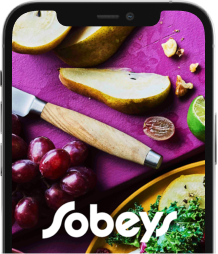Whether you call them loaves or quick breads, there’s a reason slices of Lemon Poppy Seed Loaf and Banana Bread are fixtures of coffee shops everywhere. These treats are simple to make and a perennial favourite, so why not bake up a batch in your own kitchen and customize them to the tastes of your family?
Once you master the basics and feel comfortable with one solid quick-bread recipe (scroll down for links to some of our favourites), the doors open to endless possibilities. All it takes to make a recipe your own is a little creativity.
A reliable quick-bread recipe is the ultimate in easy baking: it’s fast, comforting and defined only by the vessel you choose to bake it in and the ingredients you include. Pour a quick-bread batter into muffin tins for tender-crumb muffins; bake that same batter in a loaf pan, and you’ll be putting a tasty loaf in front of your family with hardly any effort. Unlike yeasted breads, quick breads are made with baking powder or baking soda, so you can bake them right away (hence the name), with no kneading or waiting for the dough to rise. In this guide, we show you how to play with different flours and fats, add nuts and fruit, and give a basic quick-bread recipe your own special flair from the bottom up.
Batter Basics
All quick-bread recipes follow the same basic formula: two parts each of flour and liquid, with one part each of egg and butter, plus a little baking soda or baking powder as a leavener. (Some recipes use both baking soda and baking powder: soda for browning and to support the structure of the loaf; powder for better flavour.) There are, of course, endless variations on the quick-bread ratio, depending on the desired sweetness and texture, and which extra ingredients are added, such as fruits and nuts.
To mix your batter, first whisk together your dry ingredients – flour, sugar, salt, baking powder or soda, spices, herbs and so on – until they are well mixed and a uniform colour. In a second bowl, mix together the wet items: eggs, milk, melted butter or oil, and any fruit purée you want to add.
Combine the contents of the two bowls: Make a well (hole) in the centre of the dry ingredients and pour in the wet ingredients, then mix together quickly and gently. Some lumps or small streaks of flour are okay; just don’t overwork the batter – a few quick strokes will do the job. Next, lightly fold in your add-ins, such as nuts or fruit, and scrape the batter into your baking pan of choice. (Pans of different shapes and sizes will change how long your quick bread takes to cook; consult our Baking Pan Substitution Guide for tips on baking times and to learn which pans you can use.) Darker pans promote browning, while glass lets you see how brown the bottom of your quick bread is getting.
You can play around with how ingredients are combined, too. If you want a more cake-like quick bread, use a hand mixer to cream together room-temperature butter and sugar, which will add more air to the batter. For a scone-type preparation, cut butter into the dry ingredients, and then pour in the wet ingredients.
Once your batter is ready, a well-greased muffin tin or loaf pan can make the difference between a beautiful baked good and one that has lost most of its lower half in the pan. Use butter, margarine or oil (grease pans with a folded piece of paper towel if you don’t want to get your hands dirty), or coat the pan with vegetable-oil spray. Alternatively, try paper muffin liners or invest in silicone pans, which are less likely to stick. To prevent your cooked loaves and muffins from breaking apart, let them cool in their pans on a cooling rack for five minutes before removing from the pans and transferring to the rack to continue cooling.
Creative Customization
Now comes the fun part. Let’s start with flour. Want more heft to your loaf? Replace up to half of the standard all-purpose flour with whole-wheat flour or whole-wheat pastry flour (don’t get carried away, as a little whole-wheat flour goes a long way). For gluten-free bakers, a good all-purpose gluten-free flour can be used one for one in place of all-purpose flour, but note that the texture of your loaves will be different. (For more tips on gluten-free baking, read our 10 Staples for Your Gluten-Free Kitchen.)
For those with a dairy allergy or intolerance, milks made from soy, almond, cashew or other nuts are great alternatives to cow’s milk in recipes. Canned coconut milk is another option, and it also adds a coconut flavour that goes well with bananas, carrots and pineapples. (If you’re a coconut fanatic, you can also add grated coconut or coconut oil to the batter, or use grated coconut in a sweet topping to magnify the flavour considerably.)
Bakers can choose between alternative sweeteners such as agave syrup, coconut sugar or brown rice syrup, or stick with tried-and-true brown sugar, honey, maple syrup or molasses. Try substituting up to one-quarter cup (60 millilitres) of a recipe’s sugar with one of these sweeteners. Alternatively, to cut sugar content, reduce sweeteners by up to one-third of the amount called for without losing out on texture or moisture.
Using citrus zest in the batter? Amp up its flavour by substituting some freshly squeezed juice as part of the liquid measure.
Ripe and juicy fresh fruit is a treat but can turn muffins and loaves into a soggy mess. To avoid this, place chopped fruit in a strainer for an hour to allow any extra liquid to drain before adding to the batter. (Save this juice to use in smoothies.) Another trick is to toss the fruit with a little flour, as in this Low-Fat Strawberry Tea Loaf with Lemon-Basil Glaze recipe.
For fruit flavour without visible chunks, make a purée. Try berries, peaches, nectarines or mangoes; push the purée through a strainer to remove seeds or extra fibres before adding to the batter. Or stir a spoonful of your favourite jam into the finished batter for a pretty swirl effect.
Packed with concentrated flavour, dried fruits like cherries, cranberries or apricots can be used as is or hydrated with your liquid of choice to plump them up: alcohol such as rum or brandy, as well as non-pulpy fruit juice or even plain warm water give dried fruits a softer texture in your finished baked goods. Be sure to drain off the liquid before adding your fruit to the batter, as in this Pumpkin, Cranberry & Pecan Loaf recipe.
Fruit isn’t the only option for sweet muffins and loaves. Vegetables can be superstars too when it comes to bumping up the caramel or honey flavour of your recipe – not to mention adding vitamins and fibre. Think beyond zucchini and carrots and try unexpected items such as shredded butternut squash or pumpkin, which is delicious with chocolate chips in this loaf recipe.
Vegetables also work seamlessly as a flavour addition in savoury quick breads: pickled jalapeño peppers, sautéed chopped sweet peppers, and alliums such as onions, shallots, leeks or roasted garlic are delicious in cornbread loaves or cheddar muffins.
When it comes to adding chocolate, plain chocolate chips are good, but consider chopping up your favourite chocolate bar into uneven chunks to spread nuggets of goodness throughout your batter. Chocolate chips or pieces can be folded into the batter or sprinkled on top right before placing loaves or muffins in the oven. Cocoa powder, if used, should be mixed in with the dry ingredients.
Nuts and seeds can provide a crunchy counterpart to a moist quick bread; for maximum flavour, toast nuts beforehand in a 350˚F (180˚C) oven or in a skillet on the stovetop (on medium, stirring constantly) until browned and fragrant. Watch toasting nuts carefully to ensure they don’t burn. Move beyond the traditional almonds and pecans and try macadamia nuts, cashews, peanuts, hazelnuts, pistachios or even pine nuts. Take the crunch factor up a notch by using sunflower, pumpkin, sesame or poppy seeds to coat the bottom of the muffin or loaf pan before pouring in the batter to create a seedy “crust.”
Prefer a certain spice? Cardamom or cinnamon will add flavour and a beautiful golden brown hue; use up to a tablespoon (15 millilitres), depending on your preference. A pinch of saffron can add flavour and colour, too; warm it with some of the recipe’s liquid measure for a few minutes in a small saucepan before adding the cooled saffron liquid to the wet ingredients.
Blends and pastes such as harissa (a fiery, garlicky chili paste) or curry powder can provide a warming base note to your quick breads when used sparingly – think of a savoury zucchini muffin with harissa and shredded cheddar cheese, for instance.
If you love fresh herbs, go green with your quick breads. Try rosemary, thyme, basil, parsley or tarragon, alone or paired with fruit. Or swirl a dash of your favourite pesto sauce into the batter before baking for a jolt of colour.
For the diehard carnivores in your family, pump up savoury quick breads with cooked crumbled or chopped sausage, leftover chopped or minced meats, pepperoni, kielbasa or cooked shrimp (tone down the sweetness of the quick bread by reducing the amount of sugar in the recipe, though). These Cheddar Bacon Breakfast Muffins are a good recipe to start with.
Everything tastes better with cheese‚ even quick breads. For example, figs and blue cheese, as well as grapes and havarti, are heavenly baked in a loaf. Just keep an eye on the moisture levels of certain cheeses: the difference between a sticky blue cheese and the nutty hardness of aged Parmigiano-Reggiano can make a world of difference to the texture of your batter.
Finally, when it comes to toppings, there are several ways to finish your masterpiece. Try sprinkling your creation with white or raw sugar mixed with cinnamon or other baking spices. Nuts sprinkled on top will brown nicely in the oven (best not to toast them first). Or top your muffins with granola and a drizzle of honey, like we did in our easy blueberry muffins.
Want a sweeter topping? Think of icings and glazes. An icing is made by combining creamed butter with sugar, or by cooking egg whites with sugar; it’s opaque, with some substance, and thicker than a glaze. You usually have to wait for your baked item to cool before spreading icing across it.
A glaze is translucent, more of a coating than a covering, and can (and sometimes should) be applied to warm baked goods. This is the land of dripping and drizzling – no spreading involved. Your pantry is your playground: jazz up icings and glazes with fruit juices and citrus zest, liquors, cocoa or espresso powders, nuts and coconut. To let the deliciousness permeate the whole baked good, poke holes into your loaf or muffins with a skewer before glazing.
Time to eat! And here’s an excuse to devour your muffins and loaves the day you make them: they don’t keep as well as yeasted bread and should be consumed relatively quickly. If you do want to wait, cool and keep quick breads wrapped in paper or foil for a few hours; or wrap in plastic and then foil, and freeze for enjoying later.







